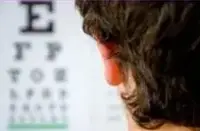Cataract Surgery
Cataract surgery is now available at Clinch Valley Medical Center.
What are cataracts?
Cataract surgery is one of the most common eye surgeries performed in the United States every year.
According to Prevent Blindness America, there are 22 million Americans over the age of 40 who have cataracts, and that number is expected to grow to over 30 million in the next five years. The problem certainly isn’t going away any time soon.
If you ask most people what a cataract is, the answer would be something like “a cloudy or hazy film that forms over the eye.” However, in actuality a cataract is when the natural lens inside your eye becomes cloudy.
In essence, protein deposits come together to create a “smudge” on the lens of your eye, much like a smudge on the lens of the camera. Unfortunately, you can’t just take a rag and some cleaner to get the smudge out of the lens of your eye (That would be a very bad idea!)
What happens when you have cataracts?

- Clouded vision caused by cataracts can make it more difficult to read, drive a car—especially at night—or see the expression on a friend’s face.
- When the lens of the eye is cloudy, it cannot focus light correctly on the retina, which can lead to a decline or loss in vision, and cause a variety of visual disturbances.
- Most cataracts develop slowly and don’t disturb your eyesight early on. With time, however, cataracts will eventually interfere with your vision.
Stronger lighting and eyeglasses can help you deal with cataracts at first, but when impaired vision begins to interfere with your usual activities, you might need cataract surgery.
Who is a candidate for laser cataract surgery?
Cataract surgery is performed to remove the cloudy natural lens from the eye, and is typically performed on patients between the ages of 60-75; however this is not always the case.
In most cases a permanent refractive intraocular lens (IOL) implant is inserted to replace the natural lens thereby restoring focusing power. Your surgeon will work with you to decide when to have cataract surgery, based on how well you are able to see during routine activities.
Many patients are able to drive, watch TV and work for a number of years after being first diagnosed with cataracts. However, if you have cataracts, you will eventually start to notice declining visual clarity – often with ghost images – which are not correctable with glasses or contacts.
Common Cataract Symptons

Blurred or cloudy vision.

Loss of vibrancy, or changes in the way you see color.

Problems driving at night due to glare form headlines or road signs.

"Second sight" where distance vision gets worse, but reading glasses are no longer required.

Dramatic, sudden changes in your glasses or contact lens prescription.
The Cataract Surgery Process
Whether you have a cataract in one eye or in both eyes, surgery is typically only performed on one eye at a time so that a patient is not trying to recover from surgery in both eyes at the same time. Cataract surgery, whether done manually or with a laser, is a relatively straightforward, simple procedure that can have a profound effect on your vision, and of course, your overall quality of life.
